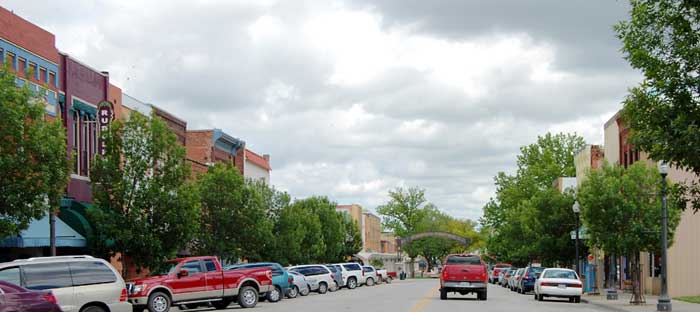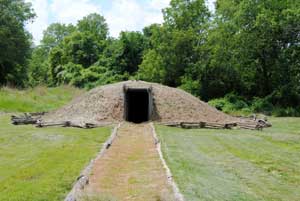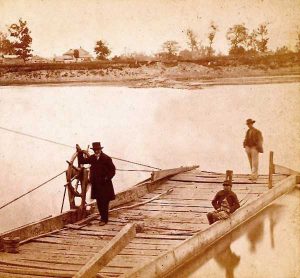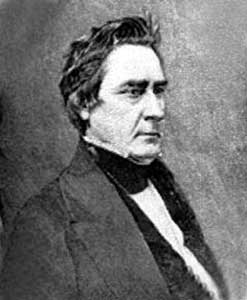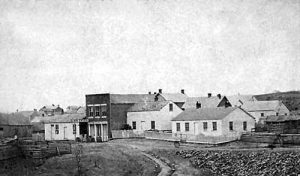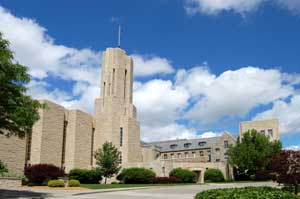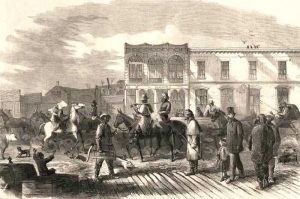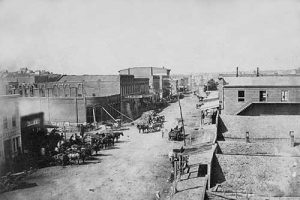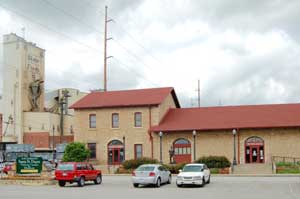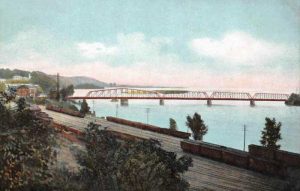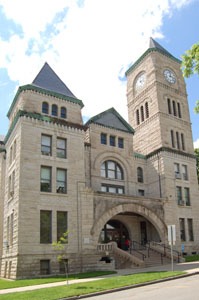Atchison, Kansas – Legends of Kansas (original) (raw)
Atchison, Kansas Business District by Kathy Alexander.
Grand Village des Canzes in Atchison County, Kansas, by Kathy Alexander.
Located in northeastern Kansas on the Missouri River, the site that would become Atchison was first home to the Kanza Indians. Their abandoned village was noted by Lewis and Clark when they explored the area on July 4, 1804, and celebrated the first Independence Day in the American West.
Fifty years later, Atchison was founded in 1854 and named in honor of David Rice Atchison, a United States senator from Missouri. When Kansas opened for settlement, he and several friends began planning to form a city in the new territory.
However, it seems that not everyone agreed on the location he had selected. On July 20, 1854, Dr. John H. Stringfellow, Ira Norris, Leonidas Oldham, James B. Martin, and Neal Owens left Platte City, Missouri, to decide on a site.
Kansas Ferry.
They crossed the Missouri River near Fort Leavenworth, Kansas, and continued to travel upstream along the western bank until they reached the place where Atchison now stands. There, they found a site that was the natural outlet of a remarkably rich agricultural region just open to settlement. They also found George M. Million and Samuel Dickson, who had staked claims near the river. Million’s claim lay south of what is now known as Atchison Street and consisted of a quarter section. Dickson had built a small cabin on his claim, and this cabin was the first structure erected on the site of the present city. Million had a ferry on which he crossed to the Missouri side to his home, but on the day the prospectors arrived, he was on the Kansas side. From a map in his possession, the prospectors found that they were at the location decided upon before leaving Missouri.
As all the men in the party, except Dr. John H. Stringfellow, had already taken claims in the valley of Walnut Creek, he was the only party member who could select a claim. He, therefore, took a tract north of Million’s. The proposition of forming a town company for the future city was laid before the first settlers. Dickson was willing, but Million did not care to cut up his claim. He offered to sell his claim for $1,000 — an exorbitant price for land at the time –, but the men from Platte City had determined to found a city on that particular spot, and the purchase was made. A town company was formed, and a week later, a meeting was held under a tree on the bank of the river, about a half-block south of where Atchison Street now runs. There were 18 people present when the town company was formally organized by electing Peter T. Abell, president; James Burns, treasurer; and Dr. John H. Stringfellow, secretary.
David Rice Atchison.
The site was divided into 100 shares by the company, of which each member retained five shares, the remainder being reserved for the common benefit of all. By September 20, 1854, Henry Kuhn had surveyed the 480 acres and made a plat. The next day was fixed for the sale of lots, an event of great importance as it had become understood that Senator David Rice Atchison would make a speech on the political question of the day. Hence, the sale would be of political and business significance. At his meeting on the 21st, two public institutions of vital interest to a new community were planned for — a hotel and a newspaper. Each share of stock in the town company was assessed 25,theproceedstobeusedtobuildtheNationalHotel,whichwascompletedinthespringof1855onthecornerofSecondandAtchisonStreets,and25, the proceeds to be used to build the National Hotel, which was completed in the spring of 1855 on the corner of Second and Atchison Streets, and 25,theproceedstobeusedtobuildtheNationalHotel,whichwascompletedinthespringof1855onthecornerofSecondandAtchisonStreets,and400 was donated to Dr. John H. Stringfellow and R. S. Kelley to erect a printing office. In February 1855, the Squatter Sovereign was issued. The first post office in Atchison was established on March 15, 1855, with Robert S. Kelley as postmaster.
For years, considerable trade had been up and down the Missouri River, which had naturally centered at Leavenworth. Still, in June 1855, several overland freighters were induced to select Atchison as their outfitting point.
Atchison, Kansas, in about 1860 by C.H. Masters.
Livingston, Kinkead & Co., and Hooper & Williams were the most important firms. The outfitting business done in Atchison was one of the most significant factors in establishing the town as a commercial center. The first merchants to open stores in the new town were George Challis, the Burns Brothers, Stephen Johnston, and Samuel Dickson.
On August 30, 1855, Atchison was incorporated. The town company had required every settler to build a house at least six feet square upon his lot, but when the survey was made, it was discovered that some of these buildings were upon school lands.
The title to the school lands remained in question for some time, but in 1857, all lands within the corporate limits of the town were acquired by the town company from the general government. In turn, the town company conveyed the lots to the individual purchasers, and the titles were finally confirmed by the court.
Border Ruffians.
During these early days of Atchison’s history, the city was heavily involved in the Kansas-Missouri Border War, as most of her initial settlers were pro-slavery advocates. Despite these troubles, Atchison grew very fast, and by the fall of 1856, she boasted some 50 new buildings.
The first private schools in the town were opened in 1857 by Lizzie Bay. The first school district was established in October 1858, and a month later, the Atchison Free High School was opened at the corner of Atchison and Commercial Streets.
Dr. John H. Stringfellow had North Atchison surveyed and platted in the fall of 1857, which started more new additions. In February 1858, John Roberts laid out West Atchison, and in May, Samuel Dickson had his property surveyed as South Atchison. Still, John Challis made another addition sometime later.
On February 12, 1858, the legislature issued a charter to the city of Atchison, which the people approved on March 2 at a special election. The first city officers were elected at a second special election on March 13, 1858. That same year, Atchison also became the county seat, with Lancaster, some 11 miles west, and Sumner, three miles south, as rivals. The following year, the Atchison courthouse would be built in the city. It would later be replaced by a stone courthouse built in 1897, which still stands today.
St. Benedict’s Abbey in Atchison, Kansas, by Kathy Alexander.
Among other early settlers in Atchison were the Benedictine monks who established St. Benedict’s Abbey in 1858. They would also establish Mount St. Scholastica in 1863. For the next 150 years, the Benedictine Brothers and Sisters would play an integral role in the community’s cultural, religious, and educational development. Their buildings and people are still prominent in the community of Atchison today.
During this time, the transportation business was immense. During the summer of 1858 alone, twenty-four trains of 775 wagons, 1,114 men, 7,963 oxen, 142 horses, 1,286 mules, and 3,730,905 pounds of merchandise came through Atchison.
Overland Freighter by W.D. Harper.
One single train – sent out by Hockaday, Burr & Co. consisted of 105 wagons, 225 men, 1,000 oxen, 200 mules, 50 horses, and 465,500 pounds of merchandise. This was the largest train that ever left any point for the West. The goods being purchased were to supply a chain of stage station stores that Hockaday, Burr & Co. had located between Atchison and Salt Lake City, Utah. By early 1859, the city boasted eight hardware establishments, 19 retail grocery stores, eight wholesale groceries, 12 dry goods stores, and 26 law firms. The population at this time was about 500.
Atchison was one of the first cities in Kansas to be connected by telegraph with the east. In 1859, the St. Louis & Missouri Valley Telegraph Company extended its line from Leavenworth to Atchison.
Atchison, Kansas by Harpers Weekly, 1866.
The town continued to bustle with riverboat traffic and sometimes had 4-5 vessels at its levee on any given day. Its economic status grew as the Overland Stage Line and Salt Lake City-based freighters made it their eastern terminus. The U.S. Post Office also made Atchison the headquarters and starting point for mail to the West. A stagecoach line from Atchison to Placerville, California, was one of the country’s longest and most important lines.
At the Civil War outbreak, three militia companies were organized in Atchison, whose members enlisted in the Kansas regiments. Early in September 1861, a home guard was organized to protect it in case of invasion from Missouri. On September 15, another company was raised and mustered into a state regiment.
In 1863, the city of Atchison raised $4,000 to assist the soldiers from the county, and after the Lawrence Massacre by William Quantrill and his men, a like sum was subscribed to assist the stricken people of that city. Citizens of the town also joined vigilance committees that materially aided the civil authorities in suppressing raiding and the lawless bands of thieves that infested the border counties.
Vintage Atchison, Kansas.
After the Civil War, when industrial life became normal, factories began to spring up in Atchison. Elevators and mills were erected; a flax mill was built; the Atchison Foundry and Machine Works, one of the most important commercial enterprises, was started, along with many woodworking factories and carriage and wagon works. Afterward, Atchison’s progress as an industrial center was steady.
As the boom days of overland trade began to fade, Atchison focused on making the city a railroad hub. With $150,000 from Atchison investors, the Atchison, Topeka & Santa Fe Railroad was founded in Atchison. Before long, the city sported several other railroads, including Burlington & Missouri River, Chicago, Rock Island & Pacific, Hannibal & St. Joseph, Kansas City, St. Joseph & Council Bluffs, and the Missouri Pacific Railroads.
The historic railroad depot in Atchison, Kansas, now serves as a museum and information center by Kathy Alexander.
The city also began significant civic improvements, including miles of paved streets, an excellent waterworks system, sewer, telephone, electric lighting, and electric railway systems. Natural gas, piped from the southern part of the state, was utilized for lighting, heating, and manufacturing.
Atchison’s boom years occurred from 1870 to 1900, and early in the 20th century, as the city boasted dozens of grand mansions, many of which still stand today, the Topeka Mail & Breeze described the town as having more wealthy men and widows in proportion to its population than any other city in Kansas.
But the city’s prosperous days were numbered. In 1910, Atchison reached its peak population of almost 16,500 people. In hindsight, they could see that a mistake made years earlier in delaying the construction of a bridge over the Missouri River was the cause of the decline. Though Atchison had built a bridge over the river in 1875, two cities – Kansas City and St. Joseph had built theirs more than a decade before, allowing those cities to continue progressing, while Atchison would eventually decline. (St. Joseph would also decline.)
Missouri River Bridge at Atchison, Kansas.
From 1910 to 1920, the town lost more than 20% of its population and continues to decline to just about 10,880 people today. Over the years, however, Atchison became known as “the city that refused to die” and had to rebuild after two flash floods swept through the downtown in 1958.
Today, though it is not the major city it was a century ago, it continues to have several manufacturing facilities and is an agricultural and commercial hub for the northeast corner of Kansas. Its dedication to preserving its rich history can be seen in the city’s historic riverfront and downtown area. Over 20 sites are on the National Register of Historic Places, displaying its boomtown days through impressive Victorian-era architecture. Five museums also showcase its diverse history, railroad heritage, Victorian past, art, and Amelia Earhart’s legacy.
If Atchison’s rich history is not enough for you, the town is allegedly the most haunted city in Kansas, but that’s a whole other story. See it HERE.
More Information:
Discover Atchison
913-674-0087
Atchison County Courthouse, Atchison, Kansas, by Kathy Alexander.
©Kathy Alexander/Legends of Kansas, updated August 2024.
Also See:
